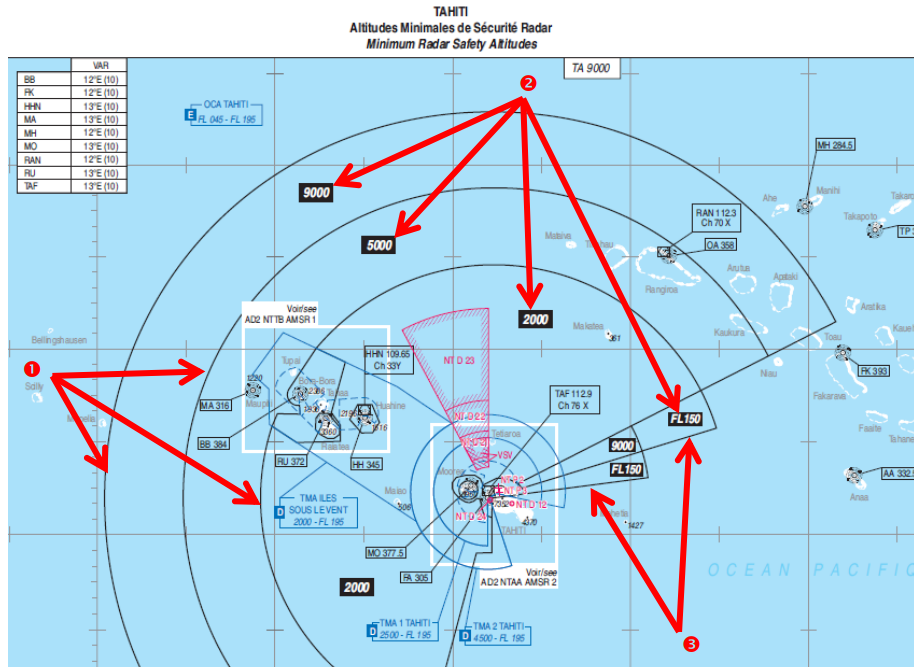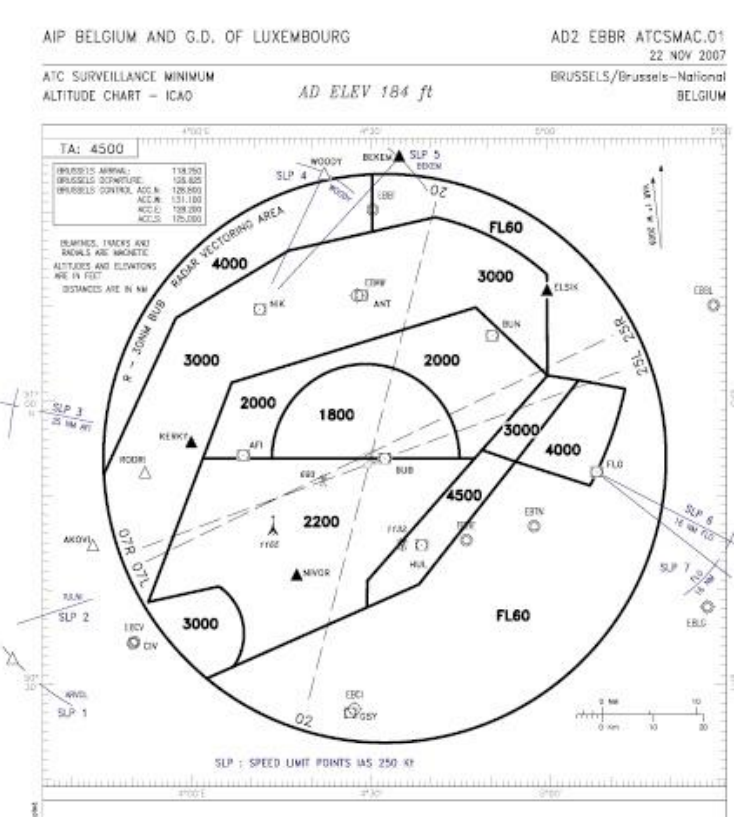¶ Introduction
Minimum (Radar) Vectoring Altitude named MVA (MRVA) is the lowest altitude, expressed in feet AMSL, to which a radar controller may issue aircraft altitude clearances during vectoring/direct routing except if otherwise authorized for radar approaches, departures and missed approaches.
MVA charts may look different from country to country and their titles may vary.
In some sources this altitude is also referred to as Minimum Flight Altitude (MFA), Minimum Radar Vectoring Altitude (MRVA) or ATC Surveillance Minimum Altitude (ASMA).
Such MVA charts should be made available where vectoring procedures are established.
Vectoring is the provision of navigational guidance to aircraft in the form of specific headings, based on the use of an air traffic services surveillance system.
¶ Design
¶ Chart representation
Each minimum vectored altitude chart contains sectors large enough to accommodate the vectoring of aircraft inside his airspace.

MVA description chart at NTAA named Minimum Radar Safety Altitudes
You can see in this chart:
- Different sectors (areas of application of a minimum vectoring altitude)
- Minimum altitude applicable for each sector
- In this chart, we got very high MVA expressed in flight level (FL150) due to mountainous area close to NTAA airfield which implies, in a specific direction, aircraft cannot be radar detected if they fly in this zone below the published altitude.
¶ Obstacle clearance
The MVA is the lowest altitude that meets obstacle clearance requirements in the airspace specified.
The minimum vectoring altitude in each sector provides 1000ft above the highest obstruction in non-mountainous areas and 2000ft above the highest obstacle in designated mountainous areas.
Each sector boundary is at least 3 miles from the obstruction used to determine the MVA in that sector.
Minimum vectoring altitudes shall be corrected for temperature (temperature correction shall be based on annual minimum temperature records).
Minimum vectoring altitudes are sufficiently high to minimize activation of aircraft ground proximity warning systems.

MVA description chart at EBBR named ATC surveillance minimum
¶ Responsibilities
¶ Pilot's responsibility
The pilot-in-command is responsible for the safety of the operation of the aircraft and the safety of the aeroplane and all persons on board during flight. This includes responsibility for obstacle clearance, except when an IFR flight is being vectored or given direct routing assisted by radar.
When ATC is not providing a surveillance service or vectoring radar and a pilot accepts a direct route away from the published route, then the pilot is responsible for maintaining obstacle clearance and the MSA should be respected in these circumstances.
Pay attention that MVA altitude can have a lower value than MSA.
The pilot-in-command shall closely monitor the aircraft's position using navigation aids and in board systems in order to minimise the amount of radar navigation assistance required and to mitigate the consequences resulting from a radar failure.
The pilot-in-command shall also continuously monitor the communication with the air traffic controller while being radar vectored and he shall immediately climb the aircraft to the minimum sector altitude (MSA):
- If the air traffic controller does not issue further instructions within a suitable interval
- In case of a communication failure.
If the flight crew believe that a cleared altitude will put the aircraft at risk of collision with the terrain, they must ask for clarification of the ATC instruction expressing their concern.
¶ ATC responsibility
The objectives of the air traffic control service do not include prevention of collision with terrain. The procedures do not relieve pilots of their responsibility to ensure that any clearances issued by air traffic control units are safe in this respect.
When vectoring aircraft off an ATS route or procedural arrival, the controller shall issue clearances such that the prescribed obstacle clearance will exist at all times until the aircraft reaches the point where the pilot will resume own navigation.
When an IFR flight is being vectored by radar, air traffic control (ATC) may assign minimum vectoring altitudes which are below the minimum sector altitude.
Minimum vectoring altitudes provide obstacle clearance at all times until the aircraft reaches the point where the pilot will resume own navigation.
- None
- None
- VID 150259 - Creation
- VID 200696 - Wiki Integration
- VID 496402 - Wiki.js integration